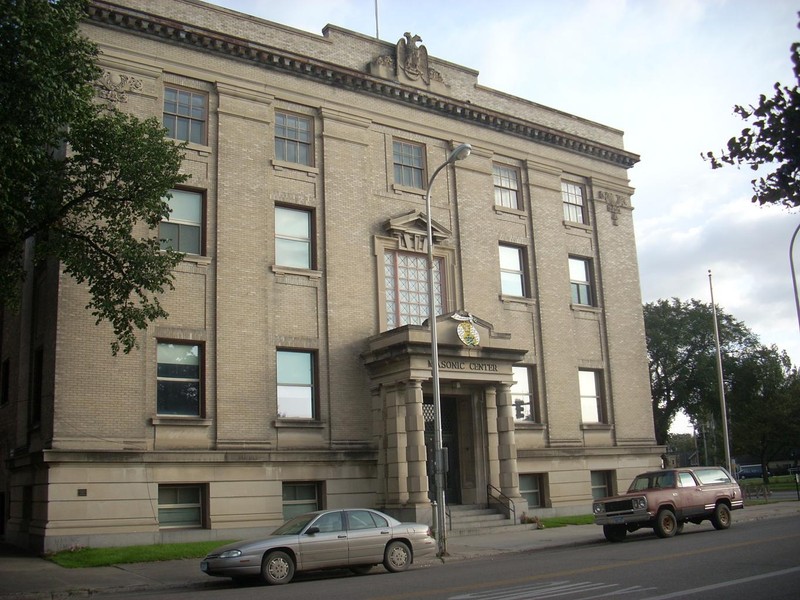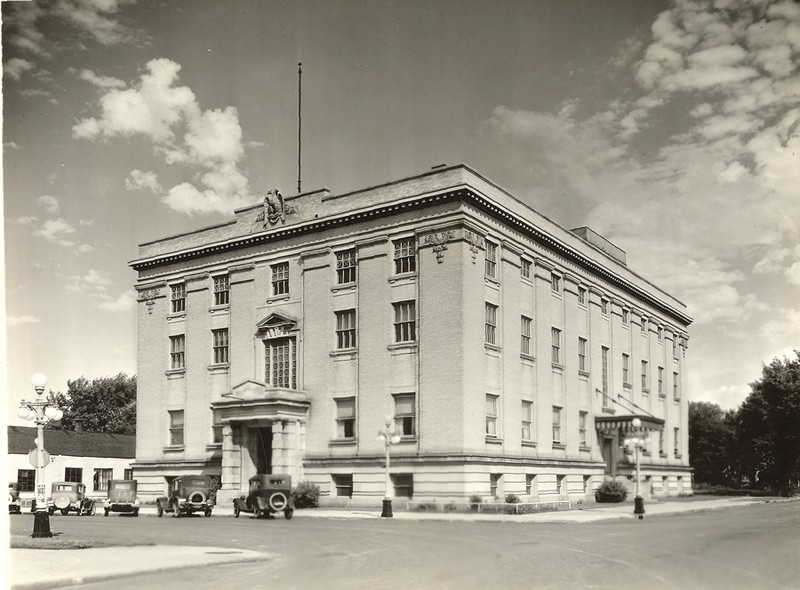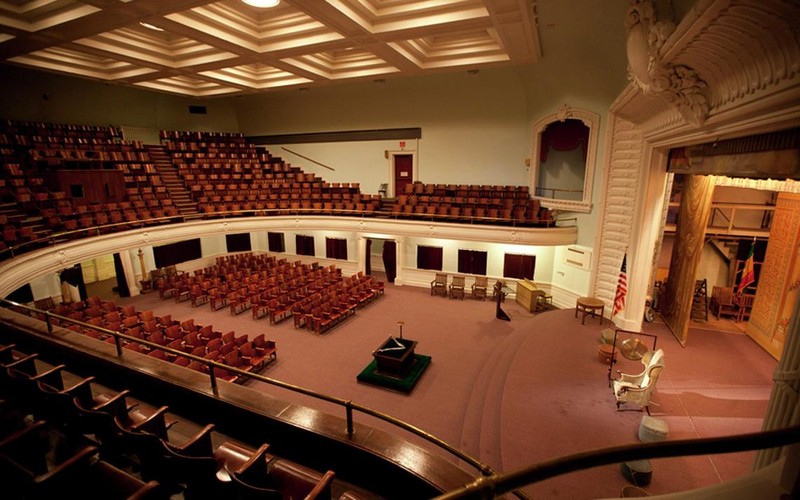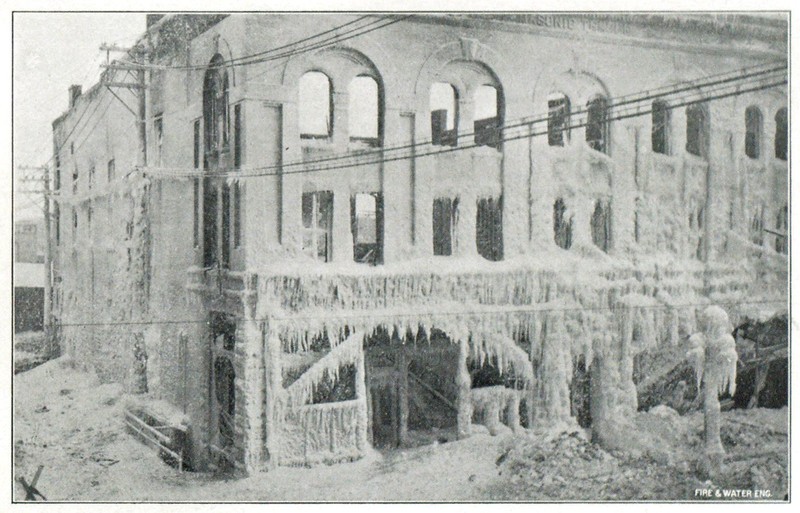Masonic Temple
Introduction
Text-to-speech Audio
Images
The Masonic Temple

The Masonic Temple (1920)

Masonic Temple Auditorium

Ruins of Original Masonic Temple

Backstory and Context
Text-to-speech Audio
The Masonic Temple in Grand Forks serves as the headquarters for Freemasons of Grand Forks. In fact, it has been their headquarters since it was constructed in 1915. Having been registered in the National Register of Historical Places in 1981, the Masonic Temple serves the Grand Forks community by enriching its Historic Down Town and hosting events.
The Masonic Temple is actually the second Masonic Temple in Grand Forks. In 1912, the original temple burned down. According to a report at the time, a neighboring hardware store, A.B. Rheinharts, were responsible for the fire due to reckless cleaning practices and oil storage. At the time, the Mason community in Grand Forks was growing. This growth came with the addition of the Scottish Rite and the Shrine, two branches of Freemasonry. With this in mind, the Masons decided the new temple had to be grander than the last. Joseph Bell DeRemer, a Mason and Shriner himself, made the designs for the new temple within the year of the first temple’s destruction. The Dinnie Brothers construction firm laid the cornerstone in 1913, and the building was dedicated in 1915.
Following the destruction of the first Masonic Temple, the Masons of Grand Forks decided the new temple had to be bigger. The Masons of Grand Forks were joined by members of the Scottish Rite and the Shriners and required larger headquarters. The building was funded by personal loans through mortuary bonds, which were payable at death with no interest, and donations from other bodies of Freemasons. Altogether, the building cost $200,000, which is worth over five million dollars today.
Joseph Bell DeRemer designed many buildings in Grand Forks and North Dakota, such as the North Dakota State Capitol skyscraper. The Masonic Temple has special significance due to its architectural style. DeRemer built many Renaissance Revival buildings in Grand Forks, including the Masonic Temple. The Masonic Temple, however, is the last of these buildings left in its original state in Downtown Grand Forks. Prior to the Masonic Temple’s registration into the National Register of Historical Places, all other Renaissance Revival buildings designed by DeRemer were either demolished or heavily altered. Over a century after its dedication, the Masonic Temple still has only had minor renovations and is practically in its original state. Though the National Register of Historic Places says the Masonic Temple is built in the Renaissance Revival Style, there is some contention among scholars. According to a brochure for the Downtown Grand Forks Historic District produced by the Grand Forks Historic Preservation Commission, the Masonic Temple is built in a Beaux Arts/ Neoclassical Style.
The Masonic Temple received shockingly little damage during the Red River Flood of 1997. It survived another disaster, an arson attempt, in 2014. Since then, the centennial of the laying of the cornerstone and the dedication of the building have taken place in 2013 and 2015 respectively.
Sources
Duan, Crystal. "Grand Forks Masonic Temple rededicated to commemorate 100th anniversary", Grand Forks Herald. June 27th 2015. Accessed April 29th 2021. https://www.grandforksherald.com/news/3775612-grand-forks-masonic-temple-rededicated-commemorate-100th-anniversary.
Haga, Chuck. "Grand Forks' masonic center opens doors of 'secret' society", Grand Forks Herald. March 30th 2012. Accessed April 29th 2021. https://www.grandforksherald.com/news/2173192-grand-forks-masonic-center-opens-doors-secret-society.
O'Leary, Peg. "Downtown Grand Forks HISTORIC DISTRICT", January 1st 2018. Accessed April 29th 2021. https://learn-us-east-1-prod-fleet01-xythos.content.Blackboardcdn.com/Blackboard.learn.xythos.prod/57fced8e8d3c5/29500669?X-Blackboard-Expiration=1619503200000&X-Blackboard-Signature=1UBOkbMDJNn1LpUNEnGjJZaAnYNuM8SxCz%2Fzu%2BpF5rw%3D&X-Blackboard-Client-Id=311616&response-cache-control=private%2C%20max-age%3D21600&response-content-disposition=inline%3B%20filename%2A%3DUTF-8%27%27Downtown%2520Grand%2520Forks%2520Historic%2520District%2520walking%2520tour.pdf&response-content-type=application%2Fpdf&X-Amz-Algorithm=AWS4-HMAC-SHA256&X-Amz-Date=20210427T000000Z&X-Amz-SignedHeaders=host&X-Amz-Expires=21600&X-Amz-Credential=AKIAYDKQORRYTKBSBE4S%2F20210427%2Fus-east-1%2Fs3%2Faws4_request&X-Amz-Signature=97a9e3f6ff2031fbf30b192bc7b4afbda074dd7ccb0e43e08df3069bbe15b4ff.
Roberts, Joe. North Dakota MPS Masonic Temple, National Archives Catalog. July 1st 1981. Accessed April 29th 2021. https://catalog.archives.gov/id/75326084.
"Grand Forks Masonic Temple Gone" Fire Engineering. February 14th 1912. Accessed April 29th 2021. https://www.fireengineering.com/leadership/grand-forks-masonic-temple-gone/#gref.
https://upload.wikimedia.org/wikipedia/commons/a/ad/Masons_Temple,_Grand_Forks_North_Dakota.jpg
https://www.gfpreservation.com/grand-forks-national-register-properties/historic-districts/historic-downtown/
https://www.grandforksherald.com/news/2173192-grand-forks-masonic-center-opens-doors-secret-society
https://www.fireengineering.com/leadership/grand-forks-masonic-temple-gone/#gref
